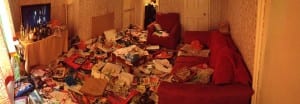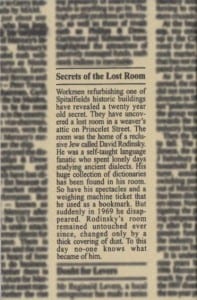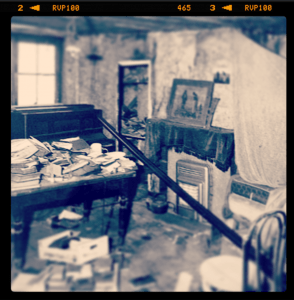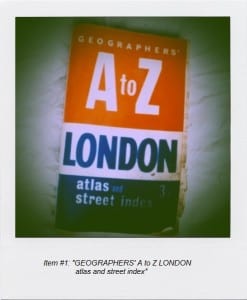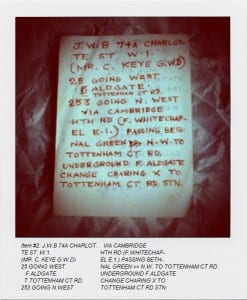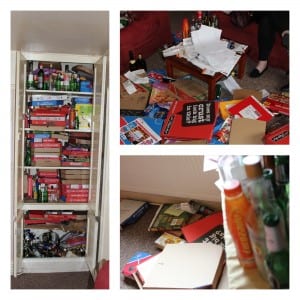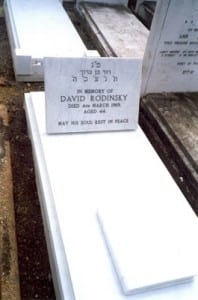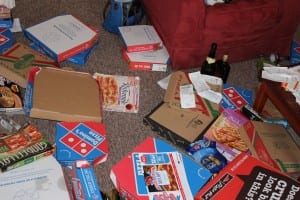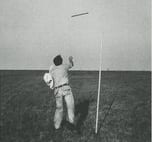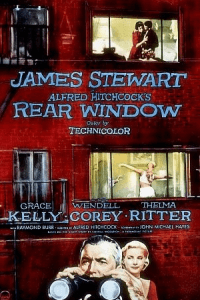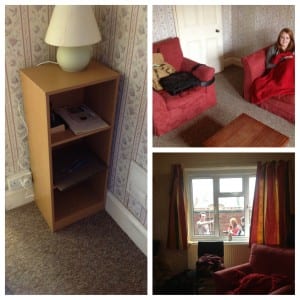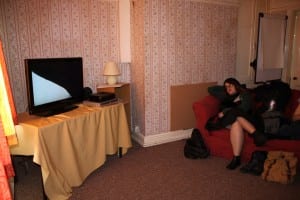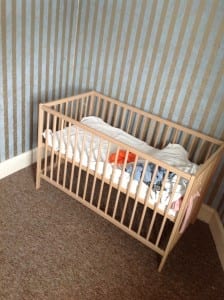After three performances, my time at East Lodge is over. I have really enjoyed the process from the very beginning when I first explored the house. At the time, I was asked to pick my favourite room; I am glad I chose the living room. It provided many different opportunities for performances due to its positioning in the house and the large amount of space available.
I think the most striking part of our performance was the fact we were completely still, unmoving and frozen in time. The notion of injecting a space that visually looks like it has been left for months with human bodies created an interesting piece of performance. I spoke with some audience members after the performance to gather feedback; I received similar responses in that they felt very uncomfortable in the room. I think this is because the audience were left to their own devices, they weren’t told specifically to do something. However, this brings me to a point in our performance where we had to adjust slightly. Originally, Hayley would bring the audience member in and ask them to sit in a particular place on the settee. However, we realised if we didn’t give them this instruction, then it gave them a choice. It opened up the possibility of allowing them to explore the space, or just simply sit in complete silence for ten whole minutes. Some waited for us to move, which also added to the tense feeling that some experienced. Others tried to interact and when they failed, they resigned to sifting through the material. Initially, we were frustrated that some audience members simply sat down for the whole ten minutes whilst some really got into the material and explored the whole of the room. However, retrospectively, for those audience members who didn’t move and stay sat down, that could be interpreted as them joining in with the performance. Perhaps they thought that they should keep still too.
Visually the room was littered with a massive amount of detritus that was collected over a long period. I personally wanted to create a lasting first impression for the audience members. This was the second performance space they would get to see and I wanted them to open that door and be completely surprised with what lay behind it. The material not only made it difficult for the audience to navigate our room, but it also gave a glimpse as to the type of people who may have lived in this space. In my previous posts, I have talked about Rodinsky’s Room; there are many other examples of rooms that have been uncovered after years of been untouched. (Most recently is this example of a Parisian apartment that has been left locked for seventy years. ((http://www.dailymail.co.uk/news/article-2323297/Inside-Paris-apartment-untouched-70-years-Treasure-trove-finally-revealed-owner-locked-fled-outbreak-WWII.html))) For me, the importance of creating that feel of a lost room was something that I think we achieved.
A panorama photo of the living room on performance day. Photo taken by Sam Davis.
Tapping into what normally happens in a living room was also important. I decided to buy different sized photo frames for the living room; I then inserted the detritus from around the living room. One photo frame for example had a Quavers crisp packet inserted into it. I think this was very effective; it is something that people do in their homes. They display photos and memories with pride, I wanted to create a similar sense but use the environment and the material around us to seed into that.
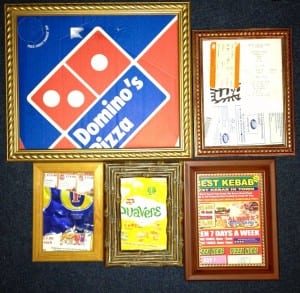
A collection of the frames that were displayed in the living room. Photo taken by Sam Davis. |
There were many ideas that developed and evolved over time. Originally, we were going to order pizza in the performance. We thought the smell and act of watching someone eat may provide an interesting performance. However, we soon realised this was too literal, we needed to think more about the space and what that could do rather than the actions of us the performers. Also we decided on four different screenshots from films that were changed each night. We used Hitchcock’s Rear Window and a recent film called Disturbia – both touch upon the act of watching someone else (voyeurism) and both have really striking images that frame what our room is about. The final image that I chose for the last performance was a pre-recorded sequence that had been filmed using the CCTV cameras, I decided to use the very beginning of this clip where the living room is empty. It provided a contrast as it showed what the room looked like before the material had taken over. It tells the audience that something has happened in this space.
A selection of the screenshots shown across the four performances.
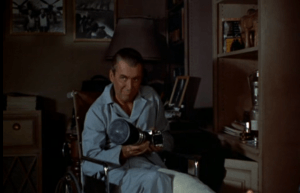 1) Rear Window film dir. Alfred Hitchock 1) Rear Window film dir. Alfred Hitchock |
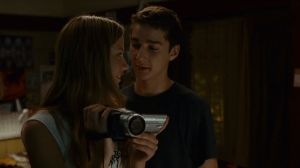 2) Disturbia film dir. D.J. Caruso 2) Disturbia film dir. D.J. Caruso |
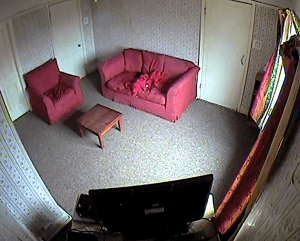 3) Pre-recorded CCTV footage 3) Pre-recorded CCTV footage |
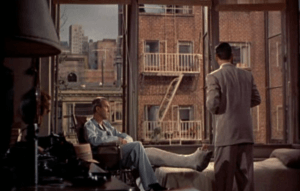 4) Rear Window film dir. Alfred Hitchock 4) Rear Window film dir. Alfred Hitchock |
We have took the neglected state of the house and created our own extreme version by using all the collected waste scattered through the room. Our aim for this, was to subvert the audiences thinking of how a room should normally be looked after. Thinking about this after the performance has also made me think about the other extreme. What would of happened if the living room was empty, there was no furniture and yet it still tried to retain the sense of being lived in by using a still human body to insert some sort of humanity.
Personally, I think site specific performances have to let the audiences share the space with them. These performances rely on some form of participation. I think our room worked well because it allowed the audience to share it with us, this is something New York artist Vito Acconci advocates:
“setting up a field in which the audience was, so that they became a part of what I was doing… they became part of the physical space in which I moved” ((Goldberg, R. (2001) Performance Art. New York: Thames & Hudson. p.156))
Whilst the performance on West Parade didn’t go to some of the extremes that Acconci does in his performances, I do agree with this statement. If audiences do become part of the physical spaces in which they enter, then they can fully share the range of emotions, feelings and understandings that is associated with site specific performance.
